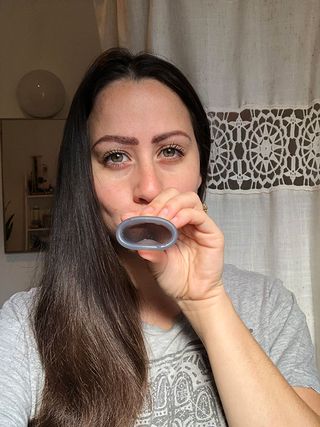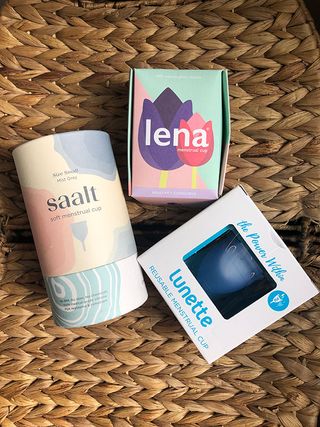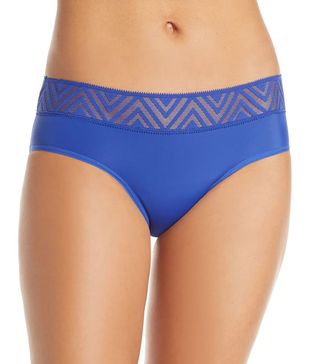These Are the Nontoxic Period Products a 25-Year-Old Cancer Survivor Swears By
When I was younger, I could not wait to get my period. I would go to the bathroom every day hoping and wishing that it was the day I "became a woman." I truly thought I was ready for the responsibility of taking care of this monthly occurrence. At the time, I didn't realize how many options there were for period care, and that some products could pose risk factors to my body, let alone the environment. My cancer diagnosis, at age 21, opened my eyes to an entire world of being cognizant of what I put in my body and what effects period products can have on our bodies.

Post-diagnosis and -treatment with cancer, I officially made the decision to live a generally nontoxic and environmentally conscious life. This meant not only exploring the foods I ate or the skincare I used, but exploring what I did once a month when my period arrived. Many period products have toxins and chemicals that can cause irritation, and sometimes lead to bigger health problems.
Switching over to the cup has not only provided me with great confidence that I am doing what's best for my body, but my budget is thanking me tremendously. One cup, that can potentially last you an entire decade, costs between $25 to $45. On average, using only disposable period products, you are likely to spend over a thousand dollars in your lifetime. Along with my budget thanking me, so is my pain tolerance. Before using the cup, I used to cramp severely and now I can say that I've seen a clear correlation between my regular cup usage and lack of cramping. My top three cup brands include Lunette, Saalt, and Lena.

So you're probably wondering, how do I know which size cup to buy, Racheli? Great question!
There are a few ways to go about this. Since most cups are all the same shape, this process can be transferable to most brands. The first thing you should do if you have access to a gynecological healthcare provider is ask them questions about your cervix and vagina length. It's not something I ever thought I'd ask out loud, but I promise it's pretty useful information.
The second step you can take is to visit Put a Cup in It and take the quiz and read all about the options you have according to your sizing. Most cup companies that I’ve encountered are extremely willing to answer your personal questions and can be a great guide to finding your perfect match; they know that you can’t return this item, so they want to make sure you get it right on your first try.
Once you've found a cup, now you need to know how to use it:
How to insert: It's important that the cup is inserted properly or else you can be uncomfortable and have the potential to leak. Wash your hands, fold the cup using the instructions on the packaging (there are a few different folds that are totally up to your preference), slide the folded cup inside, push it in until things feel comfortable and you can't feel the cup on the outside. To prevent leaking, give the base a twist to make sure the cup is completely open.
How to remove: This part seems fairly scary for everyone I’ve ever raved to about my cup before. Until now periods have seemed so gross, and the last thing we ever wanted to do was touch something that had been in the war zone we call our menstrual cycle. However, I promise you that it's not as scary as it seems! The removal is so far from messy, I was actually surprised. While sitting on the toilet or in the shower (my favorite place to do this), you just pinch the end of the cup and pull down slowly. Then you just tilt it down and drain it out.
How to clean: When I told my friend I was writing this piece, her main question was not just how do I clean my cup but how I clean it in a public bathroom. The great things about cups are that one, you don’t have to remove it when you go to the bathroom; two, they last 10 to 12 hours, so it's unlikely you'll be in a setting where you are in a public bathroom with the need to clean your cup; and three, the cups don't have to be fully cleaned every time you remove it. You can just wipe it with a paper towel or a cleaning wipe that most cup companies sell.
The next game changer for me after using a cup was the discovery of period-proof underwear. Sometimes when you're preparing to get your period and are in that suspenseful phase of "When is it going to come?!" you put on your oldest underwear that already has period stains and just hope for the best. Well, when I discovered Thinx, it all changed for me. This may have been the greatest invention of my period's lifetime. Depending on your flow, Thinx can replace pads, tampons, liners, and cups, or be worn with tampons and cups for extra protection. There is an array of styles and colors that truly make me feel cute. I've even worn them while not on my period because of how functional and comfortable these panties are. While being cute, they've also been lifesavers in situations where I could have bled through some of my favorite clothes.
Here's to a period filled with the consciousness of the effect that disposable products can have on our bodies and the environment. Are you going to make the switch?! Let me know by sending me a DM on Instagram @radiantracheli!
Next up: 6 Common Foods You'll Never See a Cancer Survivor Eat
Disclaimer
This article is provided for informational purposes only and is not intended to be used in the place of advice of your physician or other medical professionals. You should always consult with your doctor or healthcare provider first with any health-related questions.





